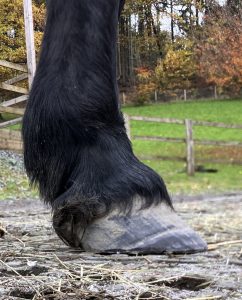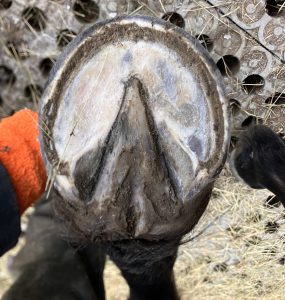Horse Welsh Section C mare.
Equine Podiatrist Helen Stowell

Background. After a yard move from one side of the country to the other, the owner had been unable to get consistent hoof care for this mare.
The mare had prior history of both excess weight and laminitis, so her bloods were already being monitored prior to the first trim appointment and she’d been prescribed ertufliglozin with good results (an initial insulin reading of 300 had been reduced to 98 by Oct 24).
The feet became very overgrown and despite best efforts, the owner was unable to get the regular hoofcare that the mare needed from her new yard. So the owner made the switch to a more local EP.
First trim December 24
At the first trim appointment it was obvious that the feet weren’t just badly overgrown; the walls were also collapsing /unable to bear the mare’s bodyweight. There was very little vertical height to the feet. The perimeter of the sole was bulging below the level of the white line indicating that P3 was sitting very low in the hoof capsule.
The excess hoof wall was hampering the mare’s movement.
 Right fore – Nov 24 |
 Right fore – Nov 24 |
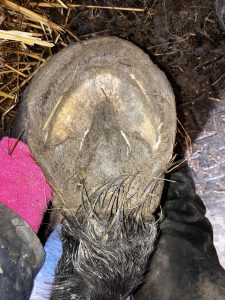 Right fore – Nov 24 |
It was decided to trim every 3 weeks, trimming to reduce the flare, whilst leaving as much height so her soles had some relief. She was yarded on woodchip surface, fed soaked hay.
February 25 blood results
By the February her blood results returned a surprisingly high insulin reading of 231 despite being on a track system and on soaked hay. So the diet was re-examined and it was decided to cut out the balancer as it had a number of potentially unhelpful ingredients.
March 25 trim
The walls were starting to recover some weight bearing capability. The toe was still producing laminar wedge and sole whilst less recessed was still stretched thin and showing signs of being under excess pressure. The trim was applied that again kept some height around the perimeter of sole, whilst controlling the length and flare of the walls. By this stage she’d rediscovered her movement and was trotting / cantering in her wood chip yard with typical Welshie flash!
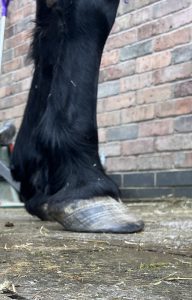 March trim lateral post trim |
March trim Dorsal post trim |
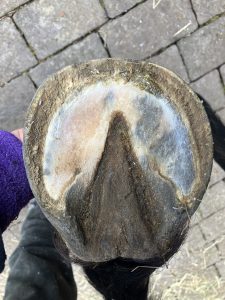 March trim Solar post trim |
By April blood tests confirmed we were back on track, with the insulin now down to 52.2.
The summer was very dry, with hardly any rain from March till September. So we had to manage ground and surfaces carefully, especially in the early part of the summer when the ground hardened quickly and her soles were still vulnerable. But over this long dry spell the walls both strengthened and straightened. Was the firmer ground helping the hoof capsule to restore its function? At this time, we could also see the sole regaining concavity – indicating that P3 was better suspended in the hoof capsule.
Again the bloods continued on the correct track, by 1 July 25 her insulin was down to 17.3 – within normal range. The growth rings were growing out, and notably the breakover of the toe was now sustaining itself.
By late summer she was off the woodchip surface, living out in a herd on a hard packed mud surface. Unbooted /barefoot and comfortable. The trim cycle was then lengthened to 4/5 weeks.
 August trim lateral August trim lateral |
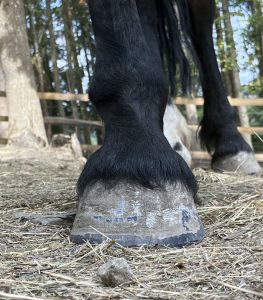 August trim dorsal August trim dorsal |
 August trim solar August trim solar |
| Dissapointing photo! Was trimmng at liberty in her paddock. At this stage the toe was maintaining its own breakover – no longer elongating | the walls are much more upright – weight bearing more effectively | The widest part of the foot is moving back towards the heels, and the sole is not encasing the frog as much |
The last set of photos is her November post trim compared to the previous year’s trim. About three weeks short of 1 year’s progress. The mare has grown out one hoof capsule.
|
Nov 25 |
Nov 25 |
|
|
|
||
 Right fore lamintic – Nov 24 |
 Dorsal Right fore – Nov 24 |
 Solar Right fore – Nov 24 |
The mare has now been given the all clear to start in hand and light ridden work.

